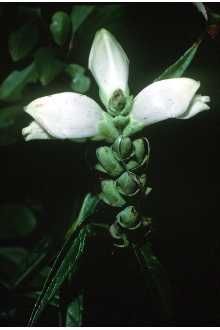Printed at http://www.newmoonnursery.com/index.cfm/
Chelone glabra
Turtlehead
Native to North America
FIRST IMPRESSIONS: Chelone glabra is an upright perennial with stout stems and shiny deep green leaves. In late summer and fall, stems are topped by lovely clusters of white snapdragon like flowers. The individual blooms are about an inch long and are elongated with 2 lips. The unique flower shape resembles the head of a turtle. Plants thrive in sunny moist or boggy sites or in frequently irrigated gardens.
HABITAT & HARDINESS: Chelone glabra is indigenous to eastern North America. Plants range from Manitoba to Mississippi and east from Newfoundland and Labrador to Georgia.
Plants occur in margins of sandy or non-sandy wetlands, including swamps, wet open woods, sedge meadows, wet prairies, seeps, marshes and shorelines of ponds or creeks. Chelone glabra is said to be an indicator of fens with alkaline groundwater.
Plants are hardy from USDA Zones 3-8.
PLANT DESCRIPTION: Chelone glabra is a sturdy perennial with attractive glossy oblong leaves. Leaves are opposite and serrate with each pair of leaves arranged on the stem 90 degrees from the pair below.
Floral displays begin in late summer and continue into autumn. The dense terminal flower spikes are white to pale pink. They are quite showy and are a valuable late season nectar source.
Individual florets are tubular with two lips. The upper lip serves as a protective hood and the lower lip is a landing strip for pollinators. The unique flower shape is reminiscent of a tortoise head.
After flowering an inconspicuous seed capsule forms.
Plants grow 2-3’ tall with 2’ spread.
CULTURAL & MAINTENANCE NEEDS: Chelone glabra grows best in full sun or part sun in wet or moist soil. Plants thrive in soils high in organic matter and tolerate seasonal flooding.
This lovely plant will flourish in garden situations if irrigated. It can also be planted in a water garden or moist perennial border.
After establishment, excess shade, competition from neighboring plants or drought are the only conditions that hinder growth.
Plants can be pruned or pinched back in spring to encourage growth of a shorter sturdier plant. This is usually not necessary unless plants are growing in full shade.
This wildflower is relatively pest resistant and fairly unpalatable to deer and other mammals.
LANDSCAPE USES: This is a good choice for a Water Garden, Bog Garden or Wet Meadow. Plants are also used as an Accent, Butterfly Nectar Plant, Butterfly Host Plant or as part of a Grouping or Mass Planting. Chelone glabra has Showy Blooms and can be used in Cottage Gardens, Deer Resistant Plantings, Rain Gardens, Low Maintenance Plantings, Wetlands and Wildlife Gardens.
COMPANION & UNDERSTUDY PLANTS: Try pairing with Acorus americanus, Caltha palustris, Iris versicolor, Lobelia siphilitica, or Osmunda cinnamomea.,
Anemone canadensis has similar height, texture and cultural needs and can be substituted if needed. Chelone lyonii ‘Hot Lips’ is a hot pink flowering cultivar that can be used in garden situations.
TRIVIA: Due to DNA sequencing, taxonomists recently moved Chelone glabra from Scrophulariaceae (the Figwort family) to Plantaginaceae (the Plantain family).
Chelone glabra is pollinated by bumblebees and visited by butterflies and ruby throated hummingbirds. Caterpillars of Baltimore checkerspot butterflies feed on the foliage. Leaves are bitter and usually not palatable to deer and other mammalian herbivores.
Height:
2-3 ftSpread:
2 ftSpacing:
3-4 ftUSDA Hardiness Zone:
3-8Bloom Color:
WhiteChelone glabra Characteristics
Attracts Wildlife
- Butterflies
- Pollinators
- Hummingbirds
Attributes
- East-Coast Native
- Cut Flower
- Clay Soil
- Bog
- Rain Garden
- Naturalizing
- Long Blooming
Exposure
- Full Sun to Partial Shade
Deer Resistant
- Deer Resistant
Flowering Months
- September
- August
Foliage Color
- Green
Soil Moisture Preference
- Wet to Moist

